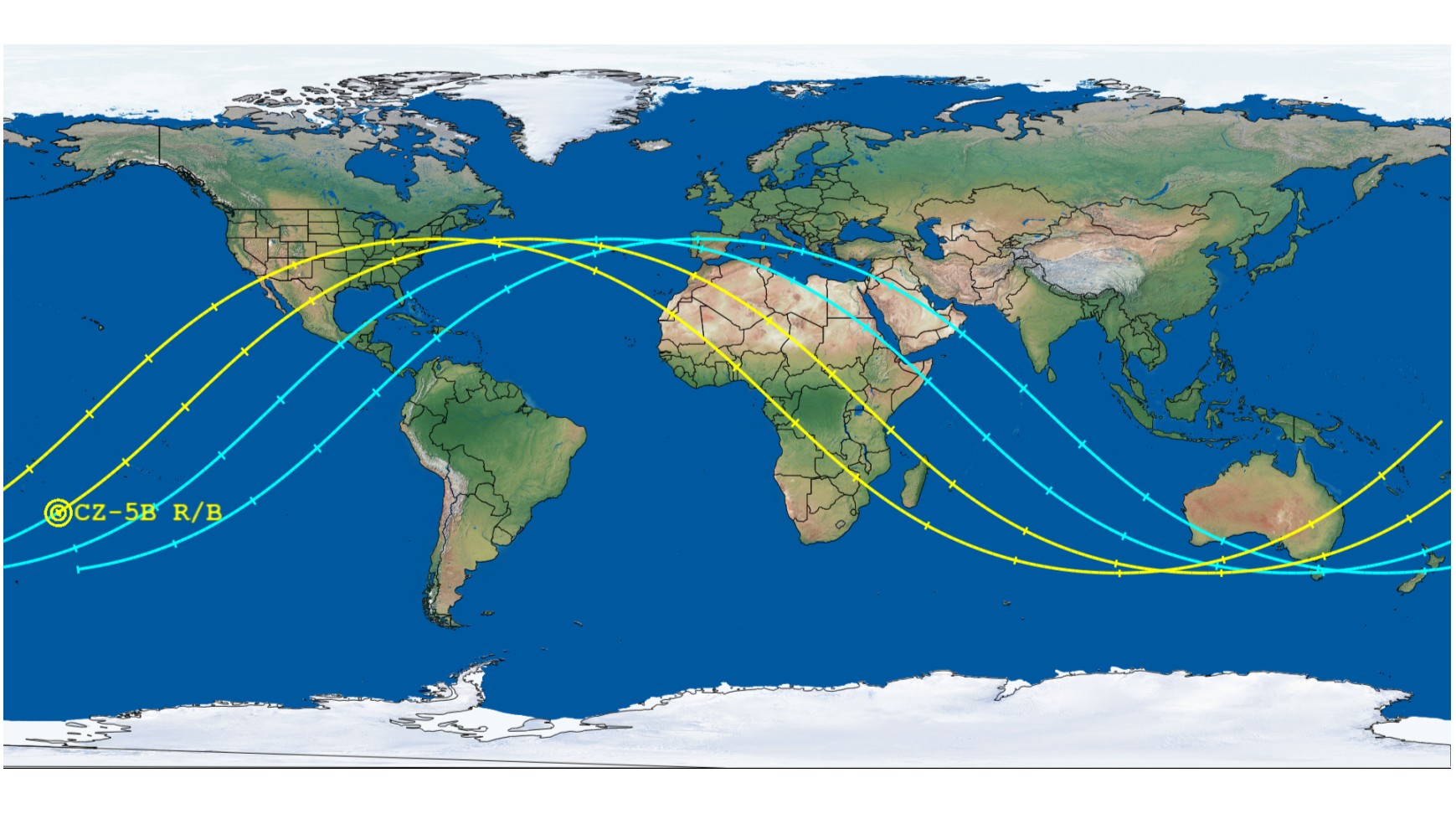Whew! 23-ton Chinese rocket debris falls to Earth over Pacific Ocean
U.S. Space Command confirmed the uneventful reentry on Friday (Nov. 4).

A 23-ton piece of space debris from China's launch of a Long March 5B rocket has fallen safely into the south-central Pacific Ocean after creating questions over where it will come down once again.
The massive piece of debris in question was left over from the core stage of a Long March 5B rocket used to launch the third and final module to China's Tiangong Space Station on Monday (Oct. 31). As in previous launches of the same rocket, China allowed the core stage to reach orbit without any way to push itself back down to Earth in a safe manner. This is becoming a somewhat common event, as the Long March 5B was not designed with any features that enable it to be safely deorbited after launch.
That means once again, the world watched and created predictions about where and when the rocket space debris would fall based on the best available data. Luckily, the massive rocket body fell harmlessly into the Pacific Ocean, according to U.S. Space Command. "#USSPACECOM can confirm the People's Republic of China Long March 5B #CZ5B rocket re-entered the atmosphere over the south-central Pacific Ocean at 4:01 a.m. MDT/10:01 UTC on 11/4," the the command wrote on Twitter this morning (Nov. 4). Space Command added that for further details, "we once again refer you to the #PRC" (People's Republic of China).
Related: Another huge piece of Chinese space junk is falling to Earth. 'Here we go again,' experts say
U.S. Space Command later tweeted that a "a second atmospheric reentry correlated with the #PRC's Long March 5B #CZ5B" occurred at 4:06 a.m. MDT (6:06 a.m. EDT/1006 GMT) over the northeast Pacific Ocean.
#USSPACECOM can confirm a second atmospheric reentry correlated with the #PRC’s Long March 5B #CZ5B as it exited the #USSPACECOM Area of Responsibility over the Northeast Pacific Ocean region at 4:06am MDT/10:06 UTC on Nov. 4. https://t.co/keJdc1tmxiNovember 4, 2022
As the falling rocket debris was being tracked during uncontrolled reentry, it caused enough alarm that a section of airspace was closed in Spain out of precaution, according to Spanish air traffic control blog Controladores Aéreos.
This is the fourth such space debris event in recent years from launches by the China National Space Administration. In July 2022, a 25-ton Long March 5B core stage fell through Earth's atmosphere over the Indian Ocean. Prior to that in April 2021, the core stage left over from another Tiangong space station mission scattered debris into the same body of water. And in May 2020, pieces of a Long March 5B made it to the ground over West Africa, reportedly leaving chunks of space junk littered across Ivory Coast.
Get the Space.com Newsletter
Breaking space news, the latest updates on rocket launches, skywatching events and more!
#USSPACECOM can confirm the People’s Republic of China Long March 5B #CZ5B rocket re-entered the atmosphere over the south-central Pacific Ocean at 4:01am MDT/10:01 UTC on 11/4. For details on the uncontrolled reentry’s impact location, we once again refer you to the #PRC.November 4, 2022
Other rockets are designed with measures in place to ensure their core stages are steered into the ocean after launch, while others like SpaceX's workhorse Falcon 9, are designed to come down in one piece and be reused. China's most powerful rocket has no such measures in place.
Unfortunately, there are no international agreements in place to prevent these incidents from occurring again in the future, said Marlon Sorge, Executive Director for The Aerospace Corporation's Center for Orbital and Reentry Debris Studies during a media briefing on Wednesday (Nov. 2). "And the reality is there aren't any real laws, treaties, internationally that govern what you're allowed to do in terms of reentry," Sorge said. "So There isn't really a direct legal way to control what's going on on an international level."
As of now, China's space agency has at least six more launches planned for the Long March 5B rocket, the soonest of which could come as soon as mid-2023.
Editor's note: This story, originally posted at 8:04 a.m. EDT, was updated at 9:23 a.m. EDT to include U.S. Space Command's statement about a second atmospheric reentry.
Follow Brett on Twitter at @bretttingley. Follow us on Twitter @Spacedotcom or on Facebook.
Join our Space Forums to keep talking space on the latest missions, night sky and more! And if you have a news tip, correction or comment, let us know at: community@space.com.

Brett is curious about emerging aerospace technologies, alternative launch concepts, military space developments and uncrewed aircraft systems. Brett's work has appeared on Scientific American, The War Zone, Popular Science, the History Channel, Science Discovery and more. Brett has English degrees from Clemson University and the University of North Carolina at Charlotte. In his free time, Brett enjoys skywatching throughout the dark skies of the Appalachian mountains.









